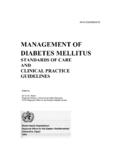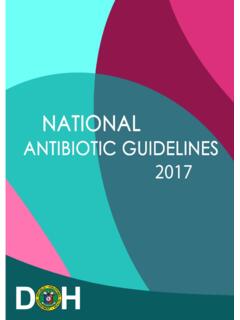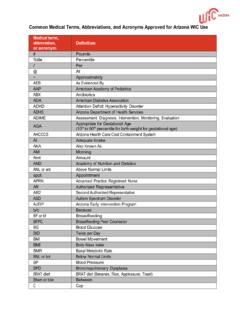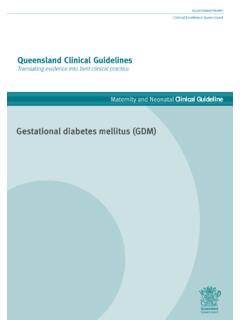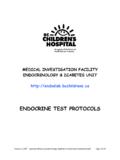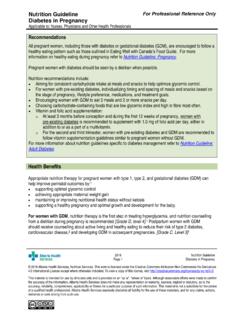Transcription of Oral Glucose Tolerance Test (OGTT) Procedures Manual
1 oral Glucose Tolerance Test ( ogtt ) Procedures Manual January 2007 TABLE OF CONTENTS Chapter Page 1 OVERVIEW OF THE oral Glucose Tolerance TEST ( ogtt ).. 1-1 1-1 Field Office Responsibilities .. 1-2 MEC 1-4 2 COORDINATOR APPLICATION .. 2-1 Coordinator 2-1 Application 2-1 Coordinator Progress Bar 2-3 Priorities and Verification Form .. 2-6 Exclusion Criteria and 2-12 Shared Exclusion Pregnancy Question .. 2-12 9-Hour Fast 2-15 No Tubes Drawn .. 2-17 Less than 1 Hour and 40 Minute Blocking .. 2-18 Return Time Expired Blocking .. 2-19 Coordinator 2-20 Assigning an Examiner and SP to the ogtt 2-26 3 TRUTOL ADMINISTRATION ogtt APPLICATION.
2 3-1 MEC Staff Responsibilities .. 3-1 Equipment and Supplies .. 3-1 Gaining 3-3 Exclusion Criteria .. 3-5 ogtt Application Overview .. 3-6 Introduce Exam to 3-7 ogtt Section 1 - Exclusion Questions and Trutol 3-8 Recording Responses to the Exclusion Questions .. 3-18 Trutol Administer 3-22 Section 3-34 iii TABLE OF CONTENTS (continued) Chapter Page 4 BLOOD DRAW ogtt 4-1 ogtt Application Section Two (Blood Draw) .. 4-1 5 LABORATORY 5-1 Laboratory 5-1 Process the 2-mL Gray Top Tube for 5-1 Record the Results of Specimen 5-2 Vessel 98 Storage 5-13 Vessel 98 Shipping 5-13 6 SPANISH SPEAKING SPs .. 6-1 Performing the ogtt on SPs Who Do Not Speak English .. 6-1 Convert Screen Text to English or Spanish.
3 6-1 List of Exhibits Exhibit 1-1 Informational flyer for oral Glucose Tolerance Test, aged 12 years and older .. 1-3 2-1 Verification form 2-7 2-2 Verification form 2-8 3-1 Equipment and supplies ogtt .. 3-2 3-2 Talking Points - English .. 3-7 3-3 Talking Points Spanish .. 3-8 3-4 Trutol Calibrated Dosage 3-23 5-1 Primary SP s ogtt processing protocol .. 5-1 5-2 Storage protocol for GTT .. 5-13 5-3 GTT shipping 5-13 5-4 Contract laboratory 5-14 iv OVERVIEW OF THE oral Glucose Tolerance TEST ( ogtt ) Introduction Because of the increasing occurrence of diabetes in younger ages, NHANES has added this component to the examination protocol to reassess the prevalence of diabetes and impaired Glucose Tolerance (IGT) in the population. Diabetes is a large, growing, and costly public health problem in the United States and disproportionately affects racial and ethnic minorities.
4 About 17 million Americans have diabetes and over 1 million new cases of diabetes are diagnosed each year. Diabetes is the leading cause of kidney failure, nontraumatic lower extremity amputation, and blindness in working-age adults, and an estimated $135 billion was spent on direct and indirect medical costs for diabetes in 2002. Alarmingly, type 2 diabetes (formerly considered an adult disease) is now being diagnosed in children and adolescents and there has been a large increase in diagnosed diabetes among adults <40 years of age. Persons with IGT percent of the population are at high risk for developing diabetes. In addition, IGT is an important risk factor for a number of other adverse health conditions and mortality. IGT is defined on the basis of an abnormal oral Glucose Tolerance test ( ogtt ). Persons without diabetes but with an ogtt 2-hour value of 140-199 mg/dl are considered to have IGT.
5 Recent national and international randomized controlled trials have shown that diabetes can be delayed or prevented among persons with IGT. Furthermore, NHANES III data indicate a tremendous opportunity for the prevention of diabetes over 12 million persons aged 45-74 have prediabetes (defined as overweight persons with either IGT or impaired fasting Glucose metabolism). These data also indicate that over 50 percent of persons with prediabetes are detected only by IGT findings. As risk factors for diabetes, IGT, and prediabetes increase ( , physical inactivity, obesity, and aging), the prevalence of these conditions is also likely to increase. The inclusion of OGTTs on NHANES will allow estimation of the prevalence of IGT and, thus, prediabetes in the population, surveillance of trends in the prevalence and awareness of these conditions, study of the risk factors for IGT and prediabetes, and examination of IGT as a risk factor for health conditions and mortality.
6 Timely data on IGT and prediabetes are particularly important as the 1-1 Nation initiates efforts to prevent diabetes among persons with prediabetes. These data on IGT and prediabetes are critical to targeting, designing, and evaluating prevention efforts such as DHHS s STEPS program and efforts by the National Diabetes Education Program. A fasting Glucose blood test is performed on all participants 12 years and older who are examined in the morning session after a 9-hour fast. After the initial venipuncture, participants are asked to drink a calibrated dose (generally 75 milligrams) of Trutol and to have a second venipuncture 2 hours (plus or minus 15 minutes) after drinking the Trutol. There are minimal risks associated with this procedure. The package label for Trutol lists the following rare but known adverse reactions: nausea, vomiting, abdominal bloating, and headache.
7 In addition, there is a rare incidence of hypoglycemia. The risks associated with venipuncture include excessive bleeding, fainting/feeling lightheaded, hematoma, infection, and multiple punctures to identify veins. Participants eligible for ogtt will have to endure the discomfort of a second venipuncture; however, they will benefit by the report of findings that will inform them if they have impaired Glucose Tolerance . The results from the ogtt will be reported to parents of participants 12-17 years and directly to participants 18 years and older in the Final Report of Findings. If the 2-hour blood Glucose values are equal to or greater than 140 mg/dL, ( , Glucose levels consistent with impaired Glucose Tolerance or diabetes mellitus), an early report will be sent. Field Office Responsibilities The field office is responsible for instructing SPs to fast and for introducing the ogtt during the household interview by using an informational flyer (Exhibit 1-1).
8 There is no change to the existing fasting remuneration. 1-2 Exhibit 1-1. Informational flyer for oral Glucose Tolerance Test, aged 12 years and older oral Glucose Tolerance Test, aged 12 years and older Why are we asking participants to have an oral Glucose Tolerance test ( ogtt )? We are asking teenagers and adults who are examined in the morning exam session to have an ogtt so we can learn more about how many people in the United States have diabetes. Why is the study of diabetes in teenagers important? Doctors and other health workers have seen an increase of type 2 diabetes in teenagers and adults over the past 20 years. This is an important problem since it can lead to many health problems such as heart disease, poor circulation, and blindness. What is diabetes? Diabetes mellitus is a group of diseases that cause high blood sugar levels. Type 1 diabetes was called insulin-dependent diabetes or juvenile diabetes and develops when the body s immune systems destroy the cells that make the hormone insulin that controls blood sugar levels.
9 Type 2 diabetes was previously called non-insulin diabetes or adult-onset diabetes. Type 2 diabetes happens when the cells in our body do not use insulin right. In the past it was seen mostly in old people, overweight people, and people who were inactive. Today, type 2 diabetes is seen more and more in children and teenagers. What will participants have to do to have the ogtt test? Participants aged 12 years and older who are examined in the morning will be asked not to eat or drink anything (EXCEPT WATER) 9 hours before coming to the exam center. They will have their blood drawn for laboratory tests that include a fasting Glucose test. They will then drink a special sugar drink. After 2 hours they will have more blood drawn to see how their body handled the sugar they drank. What will this test tell participants about their health? This test measures how the body handles sugar. We will be able to tell if a person is at risk for diabetes or already has it.
10 The person or his or her parents will be told if the test shows a blood sugar problem. Consent: Page 3 of the consent brochure has been modified as follows: Safety of tests We chose the tests and measurements because they are safe. Some of the exams or Procedures may cause you slight discomfort. Examples are collecting a blood sample or fasting for 9 hours. For the blood sample, a person will have a small amount of blood drawn from a vein in his or her arm with a needle. Participants 12 years and older with a morning appointment will be asked to drink a sugar solution and have blood taken a second time. Although rare, the sugar solution can cause nausea, vomiting, bloating, or headache. We will not ask you to have any test or procedure that is wrong for you because of a health problem or condition. 1-3 MEC Overview Diabetics taking insulin who are assigned to morning sessions are asked to fast for 9 hours so these SPs will be assigned to phlebotomy as the highest priority.











